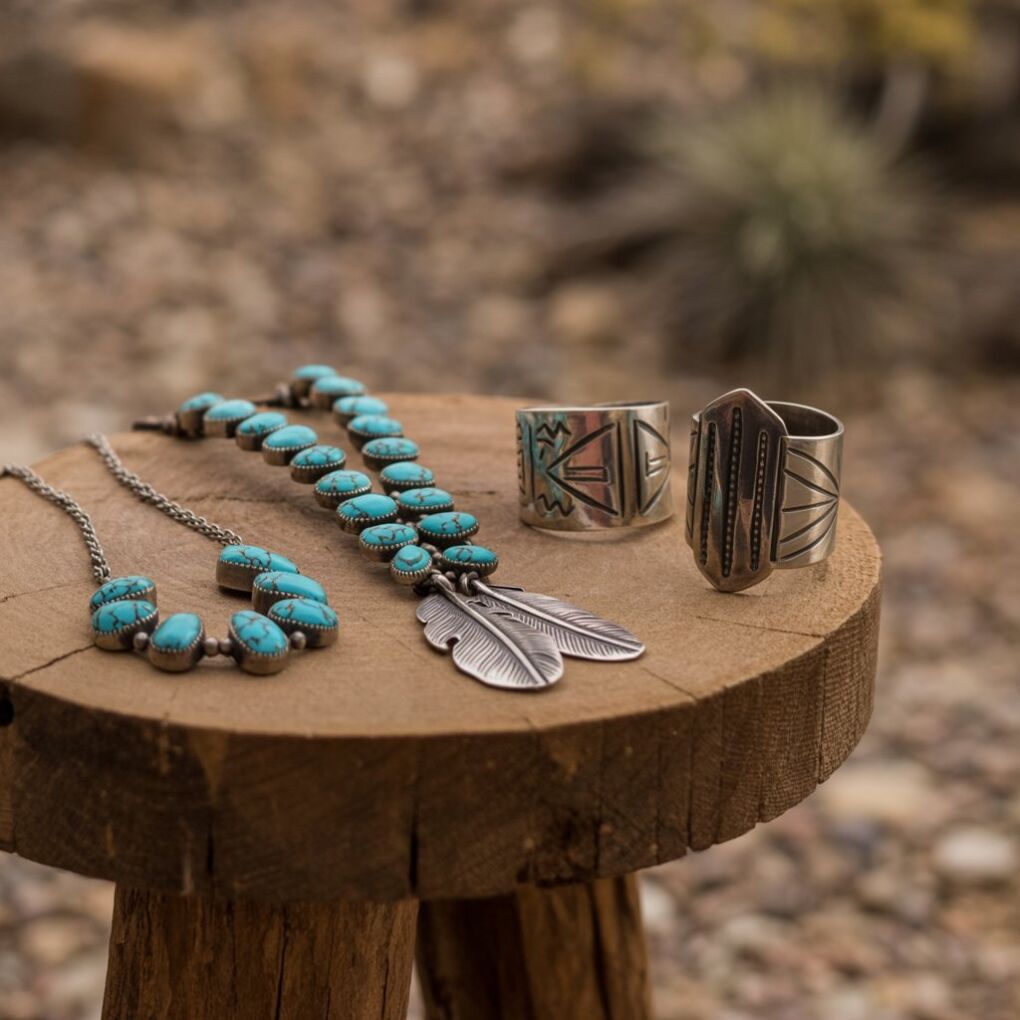Jewelry can be stylish and personal, but Native American jewelry is more than just a fashion statement; it is a form of identity, tradition, and art that is worn on the body, reflecting the rich heritage of its creators. Many people choose Native American jewelry because it carries meaning beyond its design, which features turquoise and silver, as well as intricate beadwork; each piece reflects both artistry and cultural roots.

Why Native American Jewelry Stands Out
Before we dive into the details, let’s understand what sets Native American jewelry apart. These pieces are more than just a beautiful design as they carry history, meaning, intricate craftsmanship, and tradition.
- Cultural heritage and symbolism: Many designs originate from tribes such as the Navajo, Zuni, Hopi, and Pueblo. Symbols often reflect nature, beliefs, or tribal stories that have been passed down over generations. Every pattern or shape has a unique reason behind it.
- Materials used: Turquoise is the most recognized, but coral, shell, jet, and onyx are also common stones featured in native jewelry. These natural materials are carefully chosen and handmade, often set in sterling silver.
- Handcrafted excellence: Unlike mass-produced accessories, Native American jewelry is often crafted by hand using traditional techniques. The detail, the quality, and the time it takes all show up in the final piece.
10 Statement Pieces You Need in Your Collection
Each of these native jewelry pieces has a story to tell. Some show a subtle style, while others demand attention.
1. Turquoise Cuff Bracelets
Turquoise cuff bracelets are a unique form of Native American jewelry traditionally crafted by Navajo, Hopi, and Zuni silversmiths. These cuffs use heavy silver bands set with large turquoise stones, often accented with hand-stamped symbols or rope-like silver detailing.
Many designs in these bracelets feature the “Sleeping Beauty” turquoise from Arizona, prized for its vivid, unmarked sky-blue color. “Kingman” and “Damele” turquoise are also used in cuff bracelets. These cuffs are worn alone or stacked and work well with minimalist clothing.
2. Squash Blossom Necklaces
The squash blossom necklace is bold, well-known, and rooted in Navajo tradition. It features crescent moon or a single centered horseshoe-shaped Naja pendants and silver beads shaped like stylized flower blossoms. These necklaces often incorporate turquoise or coral stones and are passed down as heirlooms. They’re usually worn as centerpieces. You’ll also find modern versions that are made lighter, but the traditional ones still hold their weight literally as well as culturally.
3. Beaded Hoop Earrings
These aren’t your average hoop earrings. Pueblo and Lakota artists hand-stitch beads onto a circular base to create patterns that range from geometric to nature-inspired. You’ll often see sunbursts, medicine wheels, or tribal patterns. Native American hoop earrings vary a lot in design. Some are made from silver with bold shapes. Others include small beads or turquoise inlaid by hand. The colors often stand for directions or natural elements. People wear them for their look, but also because they carry meaning.
4. Zuni Inlay Rings
Zuni artists are skilled at inlaying tiny stones into silver. They handshape each piece of turquoise, coral, jet, or shell, fitting them as close as possible together to form very intricate designs. Some rings depict animals such as birds or bears, while others depict natural patterns.
Needlepoint and petit point styles are especially sought after as they involve tiny hand-shaped stones arranged in sunbursts or floral patterns.
5. Silver Concho Belts
Concho belts are traditional Native American belts made with silver pieces called conchos. These round or oval discs are placed along a leather strap and often decorated with patterns or stones like turquoise or coral. People usually wear them over skirts or dresses. The belts were first made by Navajo silversmiths and were inspired by Spanish designs.
6. Thunderbird Pendants
Thunderbird pendants are often carved from silver or set with turquoise and jet inlays. Some common interpretations of the thunderbird pattern represent strength, protection, transformation, and spiritual power, and are also considered to be a powerful symbol in many Native cultures.
7. Feather Drop Earrings
Feathers are considered to be sacred in Native cultures. They often stand for honor, spiritual connection, and balance. Feather drop earrings are made with silver feathers or inlaid designs. Some of these even use real feathers or small stones for detail. These earrings have a soft, flowing look as some styles use one long feather, while others include two for a layered effect. They pair easily with both natural and modern outfits.
8. Hopi Overlay Pendants
The Hopi overlay is a special silversmithing method that uses two layers of silver. In this design, the top sheet has a design cutout, and the bottom layer is oxidized to a darker color. This effect creates depth and contrast. Common symbol features in Hopi overlay work include water waves, rain clouds, and kiva steps. Hopi overlay pendants are minimalist in form but rich in meaning. You can wear one over just a plain black shirt and witness a unique style.
9. Zuni Needlepoint Jewelry
Needlepoint is a signature Zuni technique where tiny stones are cut into narrow, tapered shapes and set into silver to form intricate floral or starburst designs. These are most often seen in earrings, rings, and necklaces. One popular design includes dozens of hand-shaped stones appearing on each piece, an extremely difficult and tedious process that demonstrates skill and patience. Although delicate in design, these pieces are visually striking.
10. Heishi Beads
Heishi (pronounced hee-shee) means “shell” in Keres, the language of the Santo Domingo Pueblo (now called Kewa Pueblo). These beads are made by hand-grinding shells, stones, or turquoise into thin, flat discs and stringing them into layered necklaces. Heishi necklaces are one of the oldest forms of jewelry in North America, featuring silverwork. They’re lightweight, earthy, and layered. Some modern styles include silver spacers, but the traditional all-stone strands remain most prized.
Tips for Wearing Statement Native American Jewelry
Bold pieces don’t need much help. You don’t need to dress up for them as they do the dressing for you.
- Keep the rest simple: Let the jewelry breathe. Solid colors and simple textures give these pieces space to show up fully.
- Mix traditional and modern: A Hopi overlay pendant over a turtleneck. A turquoise cuff with a denim jacket. These pieces aren’t locked into one style.
- Learn the story: Knowing the origin and meaning behind your piece gives you a deeper connection to it and lets you wear it with respect.
Supporting Native Artists and Ethical Buying
Owning Native American jewelry means honoring the people and cultures behind it. That starts with how you source it.
- Buy from Native-owned businesses: Make sure that you buy from certified artists and avoid misrepresentation. You can verify authenticity by researching the business’s connection to the specific tribe to verify affiliation.
- Avoid replicas: There are many mass-produced “Native-inspired” pieces that often copy sacred designs without permission or context. Although they’re cheaper, they come at a cultural cost, along with poor quality.
- Ask questions: If you’re not sure whether a piece is authentic, ask where it was made, who the artist is, and which tribe they’re a part of. Reputable sellers will have detailed information about each piece.
Final Thoughts
Native American jewelry reflects identity, heritage, and personal stories passed down through generations. Wearing a piece made by a Native artist shows respect for the culture it comes from. These pieces carry deep meaning for the people who create them. They don’t follow fashion trends, and they aren’t made to. They stand on their own. Instead of simply completing an outfit, they often become the most meaningful part of it. Each one carries history, craftsmanship, and a sense of connection you can wear.
